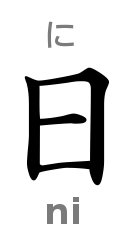Japan in Japanese: Nihon · にほん · 日本

Japan in Japanese is Nihon. This seems to be something that quite a lot of people are looking for online, which I find pretty interesting. If you’re researching how to say Japan in Japanese then presumably you don’t study the language. But maybe you should! Take your interest in this word as a sign that you should learn Japanese. Today is day one, and in a few years you could be fluent.
(By the way, if you really are interested in Japanese, you could try taking an online Japanese course).
With that in mind, I thought I’d make a simple introduction to Japanese vocabulary with the word ‘Japan’ as a base. One of the main difficulties in Japanese for beginners is how the writing system works, so this should make a nice starting point. I’ll point out here that I’m no expert, so please point out any mistakes and share your suggestions in the comments.
Japan in the Japanese “alphabet” (hiragana): にほん
I used the word “alphabet” in the title for this section, but that’s not really accurate. Japanese does not have an alphabet. The squiggly symbols you see in Japanese writing are actually a syllabary. That means that each symbol generally represents one syllable. This is different to an alphabet, in which each letter or group of letters represents one single sound.
Now, Japanese actually uses two different syllabaries. That might sound a little crazy, but it’s not a million miles away from the Roman alphabet having both lower case and upper case letters. Before I get destroyed for that analogy in the comments, I’ll point out that I’m just trying to help total beginners make sense of this.
One syllabary is called hiragana and the other is called katakana. We’re going to look at hiragana here because they’re more commonly used. Let’s use the word Japan (Nihon) as an example of how hiragana works. In Nihon we’ve got two syllables, ni and hon. The first syllable, ni, is written に in hiragana.

You can learn a little bit more about ni in hiragana here. So that’s how you write the ni from Nihon in hiragana. So what about the second syllable, hon? It looks like this:

“Wait! What? I thought there was only one symbol for each syllable?” I hear you ask. Well, you’re right - usually there is only one symbol per syllable. But syllables ending with this n sound are a special case. They get an extra symbol, ん, tagged on to indicate the final n sound. It’s still one syllable though. (Read more about ほ (ho) and ん (n) in hiragana).
Putting these three hiragana together we’ve got にほん (Nihon): Japan in Japanese.
Japan in Japanese characters (kanji): 日本
As well as the syllabaries, there’s a third component of Japanese writing. These are the famous characters, or kanji. Kanji originated in China and are very similar to the Chinese writing system that’s still in use today. Again, remember that none of these are alphabets.
The word Japan in Japanese kanji is 日本. This actually looks identical to how it’s written in Chinese as well. As you might have guessed, these two kanji are pronounced ni and hon. So 日本 = にほん = Nihon = Japan. Normally the word Nihon would be written using kanji, not hiragana.
Let’s have a look at each kanji separately. The first character is 日 (に / ni):

Putting the hiragana above a character like that is a common way to indicate the pronunciation, and is one of the uses of the two syllabaries in Japanese. This character literally means ‘sun’. You can sort of see that it looks slightly like the sun in the sky.
The next character is 本 (ほん / hon):

This character means ‘origin’. So literally 日本 (Japan) is ‘sun origin’, which you sometimes see in English as… ‘Land of the Rising Sun’. This is a very ancient name for Japan that’s still used in most East Asian countries. The character 本 (ほん / hon) is supposed to be a tree, 木, with its root marked with a line: 本. Hence it’s the ‘root’ or ‘origin’ of something.
Some resources for learning Japanese
If this little introduction has grabbed your interest, then why not go ahead and start learning Japanese? It’s a great hobby that will last you a lifetime. I’m going to recommend a few resources for learning Japanese here:
- Anki. This is a free flashcards program that’s brilliant for learning languages. The name Anki is Japanese for ‘memorise’ (暗记), and it does exactly that - it helps you learn words and sentences quickly.
- AJATT - All Japanese All the Time. A brilliant website for motivation and study techniques. This guy will set you on the right track for learning Japanese as fast as possible.
- Skritter. Skritter is a paid service that focuses on teaching you to write Japanese kanji. If you’re willing to pay the monthly fee (which isn’t too high), it’s a very good way to keep on top of your character learning.
- JapanesePod101. This is a another paid learning service. It provides audio podcast lessons and other materials for learning Japanese. Again, it costs, but can be very effective.
- Japanese Art Prints
